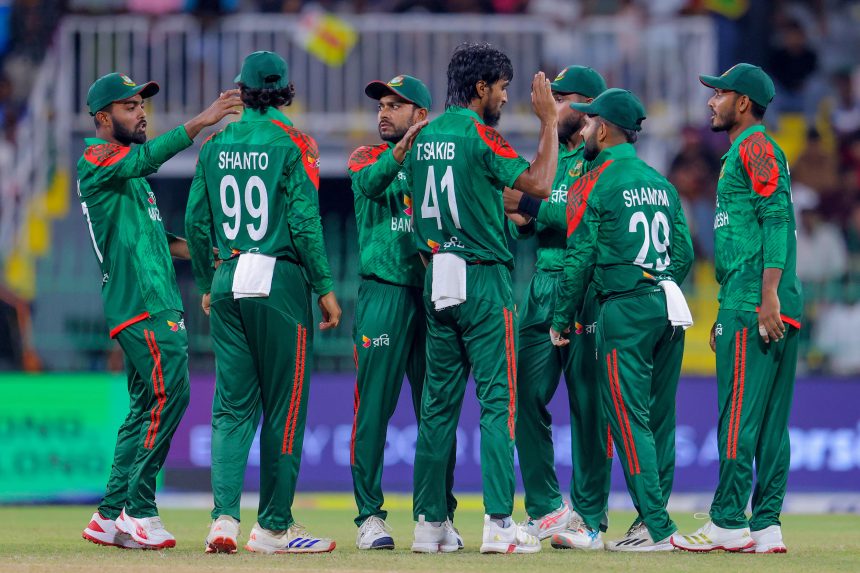Touring Sri Lanka, the Bangladesh team is travelling from one coastal area to another along the Indian Ocean. The Test series began in the historic southern port city of Galle. Despite some individual milestones, the team’s overall performance in red-ball cricket has been disappointing. The first two matches of the ODI series were held at the R. Premadasa Stadium in Colombo, on Sri Lanka’s western coast—where Bangladesh were hit hard, like by crashing ocean waves.
In the first ODI, the batting order collapsed before they could settle. However, with a win in the second match, Mehidy Hasan Miraz and his team showed they are still standing, despite being hit by turbulent waves. The three-match ODI series now stands level at 1-1. With the sea-side battles behind them, the Bangladesh team now face the challenge of conquering the hills of Kandy. If they overcome Monday’s steep climb, Bangladesh will make history by winning an ODI series on Sri Lankan soil for the very first time.
The final ODI—essentially an unofficial final—will be played in Kandy, nestled against the hills. Situated around 1,640 feet above sea level, this city is a year-round attraction for Buddhist pilgrims. The Bangladesh team has returned to the Pallekele Stadium after nearly two years, where they last lost to Sri Lanka in the Asia Cup. However, they do have fond ODI memories of this venue; in 2013, Bangladesh beat Sri Lanka by 3 wickets under the D/L method.
No players from that 2013 squad remain in Bangladesh’s current ODI setup. Only Mushfiqur Rahim and Mominul Haque are still involved in the Test format. Young Enamul Haque Bijoy has played both Tests on this tour. However, several players from the last Asia Cup clash are part of this ODI squad—such as Naim Sheikh, Tanzid Hasan, Najmul Hossain Shanto, and Mehidy Hasan Miraz—though veterans like Mushfiq and Shakib Al Hasan are absent.
In that 2013 match, Bangladesh were defending a 164-run target and lost by 5 wickets. Shakib was the most economical bowler for Bangladesh, taking 2 wickets for just 29 runs in 10 overs, including two maidens. This time around, another left-arm spinner, Tanvir Islam, has helped secure a win with a stellar bowling performance—figures of 10-2-30-5 in a must-win match. While replacing Shakib is a long journey, Bangladesh can take comfort in knowing that the process has at least begun.
Miraz secured his first win as captain in Colombo and now has the chance to claim a maiden series win abroad. The team made an impressive comeback after the first-match defeat by 7 wickets and 5 runs. Their body language and commitment were evident in the second ODI. Without that, it would have been hard to stop Janith Liyanage, who was batting fluently. Historically, Bangladesh have faltered in such scenarios—but not this time, thanks to Mustafizur Rahman.
Interestingly, Mustafizur had a rough start. He conceded four consecutive boundaries to Kusal Mendis in his first over, giving away 17 runs. After six overs, he had leaked 48 runs without a wicket and was sloppy in the field too. But in his seventh over, he delivered a maiden, and in his eighth—despite being hit for a six by Liyanage—he dismissed the dangerous batter with a slower bouncer, drawing a return catch. It was Liyanage who had threatened to crush Bangladesh’s hopes with his 78 off 85 balls in the previous match.
Another positive sign: Miraz finally picked up a wicket after five matches—finishing with 1 for 37 in 10 overs. Yet his influence went beyond the figures; he delivered 35 dot balls during the middle overs. Part-time off-spinner Shamim Patwari also bowled tightly—9 overs, 35 dot balls, just 22 runs, and 1 wicket. Together, they tightened the screws on Sri Lanka and built scoreboard pressure.
Though Pallekele’s pitch favours run-scoring, it still offers some assistance to seamers. Taskin Ahmed and Tanzim Hasan Sakib can expect some swing and seam movement with the new ball. In the middle overs, Miraz and Tanvir might get another chance to shine—provided the pitch is a bit dry. But rain could play a role too, as all of the last five ODIs here have seen interruptions.
Ultimately, the tone of the match will be set by the batters. Over the past three years, first-innings scores at this ground have averaged around 250, with 15 innings surpassing 300. The toss will be crucial—especially in day-night matches, where the chasing team has won 24 times. Miraz won the toss in the last match, and with the Pallekele chasing trend in mind, he’ll be hoping for luck again.
Parvez Hossain Emon scored a fifty in the second match, so the team is unlikely to replace him with Naim Sheikh. In the same game, Towhid Hridoy played a measured knock in the middle order. Although opener Tanzid Tamim didn’t score in the second ODI, he had a 61-run innings in the first match during a top-order collapse. The team will also be counting on him. Najmul Hossain Shanto, the former captain, got starts in both games but failed to convert them, while Miraz has yet to deliver with the bat.
To create history in Kandy, Bangladesh will need the bats of Emon, Shanto and others to carry them over the final hurdle.


